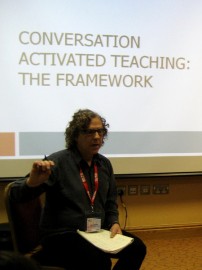 Years ago, driving from the west to the east coast in New Zealand’s South Island, we picked up a Japanese hitch-hiker (pictured in the centre above) who, once settled in the back seat, proceeded to ply us with questions from a notebook he carried. ‘What’s your favourite snack?’ ‘When did you last go to the movies?’ Even: ‘Do you believe in ghosts?’ It transpired that he had been studying at a language school in Christchurch and these were questions that his (prescient) teacher had encouraged him to formulate, in order to pursue his language learning experience ‘in the wild’.
Years ago, driving from the west to the east coast in New Zealand’s South Island, we picked up a Japanese hitch-hiker (pictured in the centre above) who, once settled in the back seat, proceeded to ply us with questions from a notebook he carried. ‘What’s your favourite snack?’ ‘When did you last go to the movies?’ Even: ‘Do you believe in ghosts?’ It transpired that he had been studying at a language school in Christchurch and these were questions that his (prescient) teacher had encouraged him to formulate, in order to pursue his language learning experience ‘in the wild’.
The term ‘in the wild’ has recently been co-opted from cognitive science (e.g. Hutchins 1995) to apply to a series of projects in which a number of Nordic countries are participating. As their website describes it,
Language learning in the wild is about using the resources available in the second language life world of the newcomers to a language[i].
This, of course, is not an entirely new idea. As long ago as 1956, Peter Strevens argued that ‘language is not a sterile subject to be confined to the classroom. One of two things must be done: either life must be brought to the classroom or the class must be taken to life’ (1956: 69).

The call of the wild
What is perhaps new in the way that this principle is being applied in places like Sweden and Iceland is that, not only are learners (or ‘newcomers’ as they are termed) being sent outside the classroom to perform certain routine tasks ‘in the wild’, but that they are encouraged to use their smartphones to record the interactions they have, as well as to collect any other linguistic data, such as signs, menus, etc, and bring these back to the classroom for analysis, discussion and strategizing for future encounters.
Moreover, many of their potential interlocutors (e.g. shopkeepers) have been primed in ways to ensure that these interactions provide optimal opportunities for learning. For example, they are encouraged not to switch straight into (global) English when interacting with the newcomer but to persist with the (local) target language. They also allow the newcomers to ‘hang out’ and watch the way the locals negotiate basic transactions. In this way, learners learn to cope with the unpredictability of even quite routine operations, such as ordering a coffee. As Wagner (2015) explains, ‘this means… that language experiences often are memorable and tellable, in a negative or positive sense’, such that, ‘in language encounters in the wild, newcomers create their own history of the second language and that history may linger for a while with new words and constructions’ (p.85). As Eskildsen and Theodórsdóttir (2017: 160) argue,
This, in effect, breaks with a long tradition of teaching language as a decontextualised object in classrooms and instead entails a mutually constitutive relationship between L2 speakers’ everyday practices and the classroom which then comes to be a pedagogically enhanced world in which a view of language as situated and locally contextualised is propagated.
Nevertheless, ‘long-term language learning in the wild is understudied’ (Esklidsen & Theodórsdóttir 2017, p. 160). One small study that does attempt to track the language development of such a learner over time (Barraja-Rohan 2015) reports how a Japanese-speaking university student in Australia improved her story-telling skills through repeated interactions with an English speaking fellow student. The researcher calls such interactions ‘conversations-for-practising’, which, essentially, is what our Japanese hitch-hiker was also doing. Barraja-Rohan (2015, p. 299) concludes:
Conversations-for-practising, centred on the participants’ needs to build social relationships rather than on curricular considerations, seem to be a valuable arrangement to bring the L2 speakers into situations of authentic, everyday social interaction and language use, i.e., into the wild.
She adds that such conversational ‘affordances’ don’t normally occur in conventional classrooms. A pedagogy based on the conversations that emerge in meaning-focused activity might redress this lack. And especially if it was a pedagogy that – like my Japanese hitchhiker’s teacher in New Zealand – equipped ‘newcomers’ to become legitimate users of the local language.
Even so, I guess the question is: how do you provide ‘in the wild’ experiences – including socialization into an English-speaking community – for EFL-type learners studying in their home country and hence lacking the direct contact my Japanese hitch-hiker was able to exploit?

Where the wild things are
References
Barraja-Rohan, A-M., (2015) ‘“I told you”: storytelling development of a Japanese learning English as a second language.’ In Cadierno, T. & Eskildsen, S. W. (eds) Usage-based perspectives on second language learning. Mouton: De Gruyter.
Eskildsen, S.W. and Theodórsdóttir G. 2017. ‘Constructing L2 learning spaces: ways to achieve learning inside and outside the classroom.’ Applied Linguistics. 38/2.
Hutchins, E. (1995) Cognition in the wild. Cambridge, Mass.: MIT Press.
Strevens, P. (1956) Spoken language: an introduction for teachers and students in Africa. London: Longmans, Green and Co.
Wagner, J. (2015) ‘Designing for language learning in the wild: creating social infrastructures for second language learning.’ In Cadierno, T. & Eskildsen, S. W. (eds) Usage-based perspectives on second language learning. Mouton: De Gruyter.
[i] http://languagelearninginthewild.com/












Recent comments